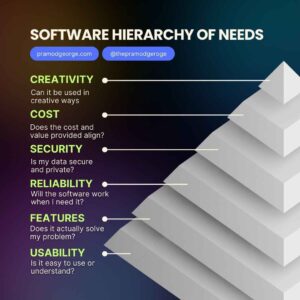The world of software is constantly evolving, and one trend that has gained significant momentum in recent years is the rise of MicroSaaS businesses.
MicroSaaS, short for Micro Software as a Service, refers to a business model where a single developer or a small team creates and operates a software product that solves a specific problem or caters to a particular audience.
The beauty of MicroSaaS lies in its simplicity, agility, and potential for profitability. Unlike traditional software companies that often require vast resources and a large team, MicroSaaS businesses can be built and launched with minimal overhead costs.
Today, thanks to Low-code, AI and The Founders Club Framework, it is possible for even non-technical non-coders to build and launch apps for 0$ in 3 to 4 weeks.
This low barrier to entry has made it possible for common people like you and me to turn our ideas into viable businesses without the need for substantial funding or a massive team.
Why MicroSAAS is the future
But why exactly is MicroSaaS considered the future of software, and why should you consider building one. Here are a few compelling reasons:
- Focus and Premium Pricing: By targeting a specific audience, MicroSaaS products can command premium pricing and avoid direct competition with larger, general-purpose software solutions. This niche focus allows for a deeper understanding of the target audience’s needs, leading to better products and higher customer satisfaction.
- Recurring Revenue Model: MicroSaaS businesses operate on a subscription-based pricing model, providing a predictable and recurring stream of revenue. This recurring revenue model not only ensures long-term sustainability but also creates a valuable asset that can potentially be sold or acquired in the future.
- Low Overhead and High Profit Margins: With a small team and lean operations, MicroSaaS businesses have relatively low overhead costs. Additionally, since MicroSaaS products are purely digital, there are no physical goods or inventory costs, resulting in high profit margins on each sale.
- Agility and Rapid Iteration: The small size of MicroSaaS teams allows for agility and rapid iteration. Developers can quickly respond to customer feedback, implement new features, and adapt to changing market conditions, giving them a competitive edge over larger, more bureaucratic software companies.
- Bootstrapping and Control: Many MicroSaaS businesses are bootstrapped or self-funded, allowing the founders to maintain full control and avoid the pressures of venture capital funding. This independence enables them to focus on building a sustainable business without the need for rapid growth or excessive external influence.
Micro SaaS is an opportunity to turn your skills and ideas into a profitable venture, while enjoying the freedom and flexibility that come with being your own boss.
The future of software is niche, agile, and focused on solving specific problems. MicroSaaS embodies these qualities, making it an attractive and promising path for those seeking to create their own successful software business.
Why is MicroSAAS the biggest LIFETIME opportunity FOR YOU?
One of the most exciting aspects of the MicroSaaS movement is that anyone can build it, regardless of their technical expertise or background.
With the advent of low-code platforms and the increasing capabilities of artificial intelligence (AI), the barriers to entry for building a MicroSaaS business have been significantly lowered.
But not just that, here are a few more reasons why MicroSaaS is the best business model for YOU!
No Original Idea Required
While having a unique and innovative idea can be advantageous, it’s not a prerequisite for success in the MicroSaaS space.
Many successful MicroSaaS businesses have been built by taking an existing concept and applying it to a specific niche or improving upon an existing solution.
The key is to identify a pain point or unmet need within a particular market segment and tailor your offering accordingly.
Low-Code Platforms
For those without extensive coding skills, low-code platforms have revolutionized the process of building software products. Tools like Flutterflow, Supabase and Buildship allow you to visually design and build applications with drag-and-drop interfaces, pre-built components, and intuitive workflows.
These platforms abstract away much of the complex coding, enabling individuals with limited technical backgrounds to bring their ideas to life.
Leveraging AI and Automated Development
The rapid advancement of artificial intelligence (AI) and machine learning has also opened up new possibilities for software development.
AI-powered platforms like Anthropic’s Claude can assist with various aspects of the development process, from ideation and prototyping to coding and testing.
By leveraging the capabilities of AI, individuals can augment their skills and accelerate the development of their MicroSaaS products.
The combination of low-code platforms, AI-assisted development, and the ability to outsource only specific tasks has made it possible for anyone with determination and a willingness to learn to build a successful MicroSaaS business.
Whether you’re a non-technical entrepreneur, a developer looking to create a side project, or someone seeking a new career path, the MicroSaaS ecosystem offers exciting opportunities for anyone to turn their ideas into reality.
How big can a micro-SaaS business become?
A MicroSaaS business can potentially become quite sizeable and successful, despite starting small. While the “Micro” in MicroSaaS implies a small team and niche focus, there’s no inherent limit on the scale a MicroSaaS product can achieve.
According to a survey by Indie Hackers, the top 1% of MicroSaaS companies reported annual revenue of over $1 million, and the top 10% earned more than $100,000 annually. These numbers highlight the significant revenue scalability that MicroSaaS businesses can achieve.
Consider the example of Basecamp, a leading project management software created by a small team at 37signals (now Basecamp). Despite its humble beginnings, Basecamp reportedly generates over $25 million in annual recurring revenue (ARR). Another success story is Drip, an email marketing automation platform founded by Rob Walling. Drip was acquired by Leadpages for over $19 million, showcasing the potential for lucrative acquisition opportunities in the MicroSaaS space.
Here are a few points to remember about the growth potential of a MicroSaaS business:
- Revenue Scalability: Even though MicroSaaS products target a specific niche, the addressable market within that niche can be substantial. As the customer base grows through effective marketing, word-of-mouth, and retention strategies, the recurring revenue stream can scale significantly. Many successful MicroSaaS businesses have reached multi-million dollar annual recurring revenue (ARR) levels.
- Team Expansion: As a MicroSaaS product gains traction and revenue increases, the founding team can gradually expand by hiring additional developers, customer support staff, and other roles as needed. While maintaining a lean team is often desirable, growth may necessitate expanding the team to handle increased workload and support customers effectively.
- Acquisition Opportunities: Successful MicroSaaS businesses with a loyal customer base, strong recurring revenue, and a profitable track record can become attractive acquisition targets for larger companies looking to expand their product offerings or enter new niches. Acquiring a well-established MicroSaaS can be a more cost-effective strategy than building a similar product from scratch.
- Product Diversification: Once a MicroSaaS business has achieved success in its initial niche, the founding team can leverage their expertise and resources to develop complementary products or expand into adjacent niches. This diversification strategy can further drive growth and revenue without deviating too far from the core competencies.
Ultimately, while MicroSaaS businesses start small and focused, their growth potential is not inherently limited. With a strong product-market fit, effective execution, and a commitment to delivering value to customers, a MicroSaaS can evolve into a highly successful and sizeable software business over time.
The Final Takeaway: Micro SaaS Empowers You
Micro SaaS is more than just a software trend; it’s a chance to take control of your financial future. With the right idea, dedication, and the resources available today, anyone can build a successful Micro SaaS business. So, what are you waiting for? Start exploring your niche, hone your value proposition, and unlock the door to financial freedom with the power of Micro SaaS!

